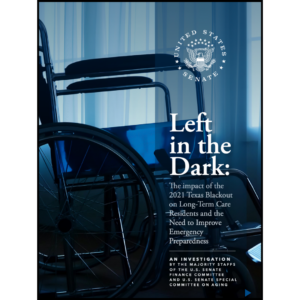The ups and downs of vertical transport
According to a news report, an 87-year-old resident of a Canadian LTC facility became stuck in the facility’s elevator on December 23 upon returning from a family function. Staff thought she decided to spend the night with family when she wasn’t seen at the facility that evening.
On Christmas Eve, staff called the family and learned that she did, in fact, return to the facility. The search began. Local police and facility staff conducted a search and finally found the resident at about 2 a.m. Christmas Day.
She had been trapped for 29 hours in an elevator taken out of service on December 24. After a hospital evaluation, she returned to the facility later that day. A family member remarked: “She couldn’t reach the emergency button on the elevator and probably wouldn’t know to push it if she could, so she just lay down and waited for someone to find her.”
This is a very dramatic situation that underscores the importance of maintaining and informing staff, residents and families when an essential service is interrupted.
I can attest that elevator malfunctions can occur anywhere and it is not necessarily the facility’s fault. I encountered a similar, but not as dramatic situation, in a six-story assisted living facility where my mom lived. A fairly large building, it was serviced by a bank of two elevators. Of course, my mother lived on the sixth floor. At one point, if I recall, both cars were down. One was soon back in operation. However, we patiently waited for repairs…and waited for repairs…and continued to wait for repairs on the second car. Meals were brought to the residents’ apartments on the upper floors, eliminating their opportunities for socialization.
I began to wonder what would happen in case of a fire or other evacuation emergency. What happens when the paramedics are called and they have to wait for the one elevator to stop and start on its journey to the lobby? My mother, who had rheumatoid arthritis and two knee replacements, was dependent on a wheelchair for mobility outside her apartment. After more than a month, while the replacement part was still on order, I decided it was time to move here somewhere else.
This was a difficult decision because the owners, staff and accommodations were wonderful and—most importantly—my mother liked the food. I worried for her safety and isolation. Our weekly beauty salon trips were cancelled.
What might have helped these situations?
In the Canadian instance, I believe the family should have escorted the lady to her quarters and let staff know she returned. LARGE signage should have been put on the elevator to inform residents and families that it was out of order.
In my mom’s case, I don’t know what could have been done other than keeping people informed of the delays and anticipated repairs. I would like to think that the owners kept pressure on the servicing company and they would have, in turn, accepted no delays from the parts supplier.
Have any of your communities experienced similar equipment malfunctions? What solutions would you suggest be used to ease the disruption, ensure safety and avoid frustration?
Related articles: 5 tips to keep emergency generators performing in LTC facilities
Does your building have an unsafe 'open door' policy?

Sandra Hoban was on I Advance Senior Care / Long-Term Living’s editorial staff for 17 years. She is one of the country’s longest-serving senior care journalists. Before joining Long-Term Living, she was a member of the promotions department at Advanstar Communications. In addition to her editorial experience, Sandi has served past roles in print and broadcast advertising as a traffic and talent coordinator.
Related Articles
Topics: Executive Leadership , Facility management , Operations











